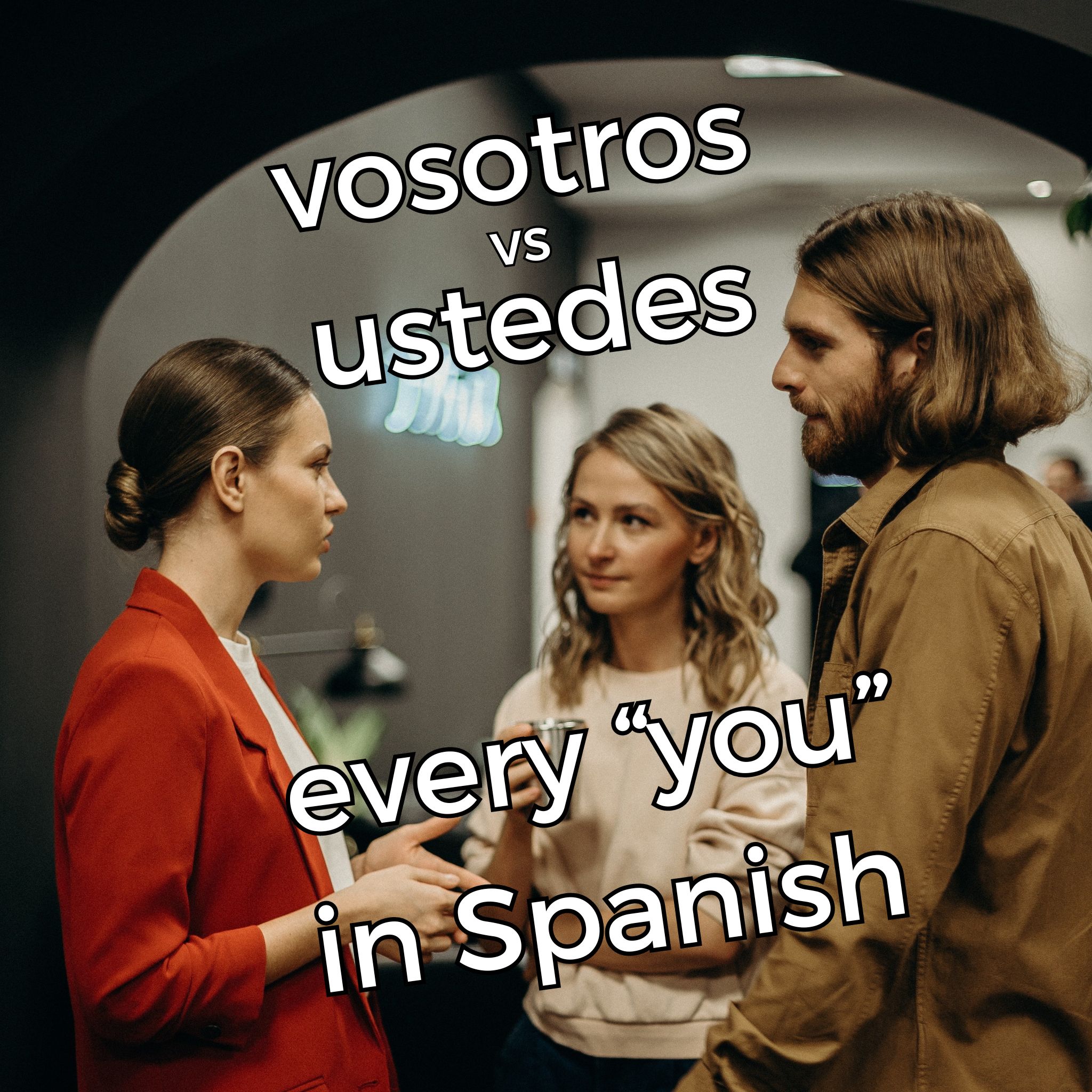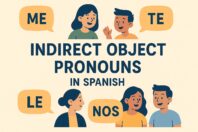Informal vs Formal You in Spanish: Tú vs Usted vs Vosotros vs Ustedes

Get our free email course, Shortcut to Conversational.
Have conversations faster, understand people when they speak fast, and other tested tips to learn faster.
More infoThe Spanish language is full of subtleties and linguistic nuances that learners encounter from the very beginning. One of the first such lessons is the difference between tú vs usted: the informal and formal you in Spanish. However, while you may be familiar with these differences in the singular, not everyone is aware of the existence of another dichotomy regarding the level of formality in the plural: vosotros vs ustedes.
In today’s post on you in Spanish, we bring you everything you need to know about tú vs usted vs vosotros vs ustedes. We’ll start with the basics, explaining each option for the Spanish you: informal and formal, singular and plural. To give a bit of background on how these different forms arose, we then delve into some linguistic history of the Spanish language over time and space, explaining these quirks in expressing the informal vs formal you.
For completeness, we finish our post with some sections on grammatical particularities, namely how verbs are conjugated for each Spanish you form. We’ll also go over the direct and indirect object pronouns that each Spanish you can become, as well as their respective possessives.
Now let’s get to it!
Informal vs formal You in Spanish
There are several ways to say you in Spanish. The right choice depends on the number of people you’re talking to, the degree of formality, and the region you’re in.
In addition, the informal plural you used in Spain has two forms, depending on whether you’re addressing men or women: vosotros vs vosotras.
Before we look at each one individually, here’s a summary of the different yous in Spanish. In the first table we see that Spain and Latin America both use the same informal and formal you in Spanish when addressing a single person. It’s in plural where there’s a difference between regions, with vosotros vs ustedes as the informal you. The formal you is the same in both regions: ustedes.
| singular you in Spanish | Spain | Latin America |
| informal | tú | tú |
| formal | usted | usted |
| plural you in Spanish | Spain | Latin America |
| informal | vosotros, vosotras | ustedes |
| formal | ustedes | ustedes |
Now let’s look at each Spanish you form in more detail.
Tú: The informal singular You in Spanish
Tú is the informal singular you in Spanish, in both Latin America and in Spain.
The pronoun tú is used as the informal you with friends, family, and people close to us.
Tú has its own verb conjugation in Spanish: the second-person singular.
Usted: The formal singular You in Spanish
Usted is the formal you in Spanish. This is the singular form, used to address both men and women in both Spain and Latin America. It’s in the plural formal you that the two regions differ.
Usted is used with people we don’t know very well, or as a way to show respect. We always use usted when addressing the elderly or authority figures, for example.
Even though usted is used as a second-person pronoun, it does not have its own conjugation pattern. Grammatically, usted is considered as a third-person singular pronoun, so verbs follow the same conjugations as él and ella.
Vosotros / Vosotras: The informal plural You in Spain
In Spain, there are different plural pronouns for the Spanish you that correspond to the singular tú: vosotros and vosotras.
Unlike tú, usted, or ustedes, this plural Spanish you has two gendered forms: vosotros and vosotras. We use vosotros to address an all-male or a mixed-gendered group of people, while vosotras is used to talk to a female-only group.
The shorthand for including both genders is to include both endings as vosotros/as, or sometimes as vosotr@s. Inclusion is nonetheless generally implied simply by using the default form of vosotros, as we’re doing through most of this post.
Grammatically, when conjugating verbs, vosotros takes a unique set of second-person plural conjugations.
So where is vosotros used? It’s important to emphasize that, nowadays, vosotros is used in Spain only. And even in Spain, there are some parts where it’s not really used, such as the Canarias and Western Andalucía. Vosotros/as is not used in Latin America.
Let’s review the contexts when vosotros is used in Spain. Since vosotros is the informal you in Spain, these are the same contexts as for tú, but in plural.
- When talking to friends, family members, or peers of your own age group.
- When addressing children or teenagers, even if they’re not closely related to you.
- In casual conversations, social gatherings, or relaxed environments.
Now let’s see a few examples using vosotros and vosotras:
- Vosotros estáis invitados a mi fiesta de cumpleaños. – You are [all] invited to my birthday party.
- ¡Mamá, papá, vosotros sois los mejores padres del mundo! – Mom, Dad, you are the best parents in the world!
- Vosotras sois como hermanas para mí. – You are like sisters to me.
Remember, vosotros and vosotras are the plural counterparts to the singular tú. Although it may seem logical, singular versions in the form of “vosotro” or “vosotra” do not exist.
Ustedes: Spain vs Latin America
To make a long story short, ustedes is the plural form of usted, so it’s the formal plural you in Spanish.
Similarly to usted in the singular, ustedes triggers verb conjugations that follow the third-person plural forms. This means that conjugations using ustedes are identical to those for ellos and ellas.
In Spain, the distinction of formality is respected in plural by choosing between vosotros vs ustedes when addressing people informally vs formally. Here are some situations where you would use ustedes in Spain:
- When addressing people you don’t know well or have just met.
- When speaking to older individuals, regardless of your relationship.
- When interacting with teachers, bosses, colleagues, or other authority figures.
- When speaking to people you hold in high esteem, like mentors or public figures.
In Latin America, on the other hand, there is no distinction of formality when addressing multiple people: ustedes is always used when talking to more than one person, regardless of formality. This means that, in Latin American Spanish, you’d always use ustedes, whether you’re addressing a group of children or a group of senators.
Vosotros vs Ustedes: Historical background
The evolution of the various forms of you in Spanish sheds light on why some of these differences persist across the Spanish-speaking world. Let’s look back to Europe many centuries ago, when there was even still a formal you in English: thou.
In the Middle Ages, the pronouns tú and vos coexisted, the latter being used out of respect for people of high social standing. However, its ambiguous use in both singular and plural was remedied by adding the Spanish word otros, meaning others, to vos, creating vosotros.
At that point, the forms of Spanish you were tú (singular informal), vos (singular formal), and vosotros (plural). However, the overuse of vos resulted in the loss of its distinction and formality. Nobles and people of high social status sought a way to be treated with proper deference, so vuestra merced (your mercy) and vuestras mercedes (your mercies) emerged as a way to maintain that courtesy. Over time, these evolved into usted and ustedes, which are still used to show respect and formality in Spain.
Vosotros gradually disappeared in Latin America, with ustedes serving as the sole plural you form. In Spain, vosotros lost its formality and became the plural counterpart to tú.
As the language evolved over the centuries, the use of vos actually still persisted in a few regions farthest from Spain. The practice of using vos, known as voseo, is still alive in Argentina, Chile, Uruguay, and some areas of Central America. There, vos is used instead of tú; we explain its contemporary particularities in our post about voseo in Spanish.
Grammar: Second person vs Third person
So far in our discussion of when to use each form of you in Spanish, we gave a passing mention to how each one is considered gramatically when we refer to grammatical persons. In English, you is clearly a second-person pronoun. Here’s a refresher on what we mean by grammatical persons:
| grammatical person | singular | plural |
| first person | I | we |
| second person | you | you |
| third person | he, she, it | they |
In Spanish grammar, however, only tú and vosotros/as are considered second-person pronouns. Usted and ustedes are considered third-person pronouns. This affects verb conjugation when using these pronouns, as well as other related forms such as object pronouns and possessives. We’ll look at those in the following sections, but for now let’s just review how these subject pronouns are considered as grammatical persons:
| grammatical person | singular | plural |
| first person | yo | nosotros, nosotras |
| second person | tú | vosotros, vosotras |
| third person | él, ella, usted | ellos, ellas, ustedes |
Now let’s look at different grammatical contexts where this difference in grammatical person manifests itself between our different forms of you in Spanish.
Conjugation
When conjugating using tú and vosotros, our verb conjugations have distinct second-person forms. Usted and ustedes, on the other hand, take the third-person conjugations. Let’s see this in action with multiple versions of a simple example sentence:
- Tú hablas español. – You speak Spanish.
- Usted habla español. – You speak Spanish.
- Él habla español. – He speaks Spanish.
- Vosotras habláis español. – You speak Spanish.
- Ustedes hablan español. – You speak Spanish.
- Ellas hablan español. – They speak Spanish.
As you can see, tú and vosotros/as have distinct conjugations, in contrast to usted and ustedes which take the same conjugations as other third-person subjects.
You may have also noticed that there’s an accent mark on the vosotros conjugation. This is usually the case, although this rule has exceptions as it depends on phonetic conditions.
Since ustedes is used in both Spain and Latin America, its conjugation is well-known and understood by both. However, many Latin Americans struggle to conjugate correctly with vosotros. In fact, vosotros conjugation seems quite foreign to people in the region, as it’s not regularly taught or seen. If your goal is to speak Latin American Spanish, you can certainly get away with not learning the vosotros conjugations!
Direct object pronouns
Direct object pronouns help clarify who is being affected by a verb’s action. Let’s review the table of direct object pronouns that correspond to each grammatical person. Remember that usted and ustedes are considered as third-person pronouns.
| grammatical person | singular | plural |
| first person | me | nos |
| second person | te | os |
| third person | lo, la | los, las |
A particularity with the direct object pronouns corresponding to usted and ustedes is that, contrary to the gender-neutral aspect of the subject pronoun, their direct object pronouns need to reflect the gender of the person. The inverse is true for vosotros/as, whose direct object pronoun is os for both masculine and feminine.
- Te quiero muchísimo, mi amiga. – I love you very much, my friend.
- Buenos días, Señor Díaz. ¿Usted está listo para partir? ¿Lo espero? – Hello Mr. Díaz. Are you ready? Shall I wait for you?
- Usted es muy admirada, Señora. La considero una inspiración. – You are much admired, Ma’am. I consider you an inspiration.
- Os quiero muchísimo, amigos. – I love you very much, my friends.
- ¿Disculpen, ustedes van a la reunión? ¿Los espero? – Excuse me, are you [all] going to the meeting? Shall I wait for you?
- Ustedes son muy admiradas, ingenieras. Las consideramos valiosas para nuestro proyecto. – You are much admired, engineers. We consider you valuable to our project.
Indirect object pronouns
Here’s our table of indirect object pronouns in Spanish. Those in the second person correspond with tú and vosotros/as, while those in the third-person correspond with usted and ustedes. There is no differentiation by gender.
| grammatical person | singular | plural |
| first person | me | nos |
| second person | te | os |
| third person | le | les |
- Te hice un pastel de cumpleaños. Espero que lo disfrutes. – I made you a birthday cake. I hope you enjoy it.
- Le envié la invitación a usted por correo. – I sent the invitation to you by mail.
- Le deseo un buen viaje a usted. – I wish you a good trip.
- ¿Están ustedes dos comprometidos? ¡Felicidades! ¡Os ofrezco una ronda de champán para celebrar! – You two are engaged? Congratulations! I offer you a round of champagne to celebrate!
- Les envié la invitación a ustedes por correo. – I sent the invitation to you by mail.
- Les deseo un buen viaje a todas ustedes. – I wish you all a good trip.
Note that in several of the examples we just saw, we also repeated the indirect object using a prepositional pronoun (each of which is preceded by a). These are not necessary in English, so our translations are still translating the bolded Spanish indirect object pronouns as you (or to you).
Possessives
Possessives help establish ownership and clarify relationships between individuals and the things they possess. Just like the other grammatical aspects we’ve already looked at, tú and vosotros/as have their own unique set of possessives, while usted and ustedes use the same ones as the other third-person subjects.
There are two types of possessives in Spanish: possessive adjectives and possesive pronouns. Mixing the two up is a common mistake made by intermediate Spanish learners, so we’ll address each of them separately here.
Possessive adjectives: Your in Spanish
Possessive adjectives are used before nouns to express that the noun belongs to someone. In Spanish, possessive adjectives are chosen depending on possessor, and they take different forms to agree in gender and number with what’s possessed.
In English, the possessive adjective for you is your. In Spanish, this becomes tu or tus for tú, vuestro, vuestra, vuestros, or vuestras for vosotros/as, and su or sus for both usted and ustedes. (Since they correspond to the third-person, su and sus are the same possessive adjectives used for él and ella, in which case they’re translated as his or her; when used for ellas and ellos they’re both translated as their.)
To sum these up, here’s a table of the possessive adjectives that all mean your in Spanish. We organize them by owner, with the different forms depending on the gender and number of the possession.
| possessor | for singular possessions | for plural possessions |
| tú | tu | tus |
| usted | su | sus |
| vosotros | vuestro, vuestra | vuestros, vuestras |
| ustedes | su | sus |
Here are some examples for when we’re talking to a single person who we’d address as tú. As you can see, there’s an important distinction between tú vs tu!
- Tu familia es encantadora. – Your family is lovely.
- Tus hijos cantan en el coro. – Your children sing in the choir.
In these next examples we’re talking to more than one person who we’d all address as tú, so in plural we’d address them as vosotros/as (the gender of the possessor doesn’t affect the possessive adjective).
- ¡Vaya! Vuestro carro es muy espacioso. – Wow! Your car is very spacious.
- Vuestra familia es encantadora, chicas. – Your family is lovely, girls.
- ¡Gracias por venir a mi fiesta, chicos! ¡Me encantaron vuestros regalos! – Thanks for coming to my party, guys! I loved your gifts!
- Gracias, amigas. Vuestras palabras me conmueven. – Thank you, friends. Your words move me.
In these examples, we can’t tell if we’re addressing a single person with usted, or multiple people with ustedes. In fact, we’d use the exact same wording if we were talking about a third person, so each translation as your could just as easily be his, her, its, or their.
- Su perro es muy inteligente. – Your dog is very smart.
- Su casa tiene muchas ventanas. – Your house has many windows.
- Sus hijos cantan en el coro. – Your children sing in the choir.
- Sus galletas favoritas son las de chispas de chocolate. – Your favorite cookies are chocolate chip cookies.
Possessive pronouns: Yours in Spanish
Possessive pronouns indicate ownership or possession of a person or thing by replacing the noun to which they refer. They show who something belongs to without needing to repeat the noun. Like the possessive adjectives, each Spanish you has its corresponding possessive pronoun, each of which has multiple forms to reflect the gender and number of the possession.
In English, the possessive pronoun corresponding to you is yours. In Spanish, for tú this becomes tuyo, tuya, tuyos, or tuyas, for usted and ustedes it becomes suyo, suya, suyos, or suyas, while for vosotros the possessive pronouns are identical to the possessive adjectives: vuestro, vuestra, vuestros, and vuestras.
To sum these up, here’s a table of the possessive pronouns that all mean yours in Spanish. We organize them by owner, with the different forms depending on the gender and number of the possession.
| possessor | for singular masculine possessions | for singular feminine possessions | for plural masculine possessions | for plural feminine possessions |
| tú | tuyo | tuya | tuyos | tuyas |
| usted | suyo | suya | suyos | suyas |
| vosotros | vuestro | vuestra | vuestros | vuestras |
| ustedes | suyo | suya | suyos | suyas |
In these examples, we see yours in Spanish where we’d address the person as tú.
- Olvidé mi bolígrafo. ¿Puedo usar el tuyo? – I forgot my pen. Can I use yours?
- Esa bicicleta no es tuya. – That bike is not yours.
- ¿Son tuyos estos libros? – Are these books yours?
- Las galletas de mi mamá son buenas, pero las tuyas son mejores. – My mom’s cookies are good, but yours are better.
In these next examples, we see yours in Spanish where we’re addressing multiple people informally.
- El siguiente vuelo es el vuestro; el mío sale a medianoche. – The next flight is yours; mine leaves at midnight.
- ¡Oigan, chicas! Creo que esa gata es la vuestra. ¿Se habrá escapado? – Hey, girls! I think that cat is yours. Did she run away?
- Nuestros hijos se parecen mucho, pero no tanto como los vuestros, ¡parecen gemelos! – Our kids look a lot like each other, but not as much as yours, they look like twins!
- Siempre lo digo, chicos, no hay fiestas como las vuestras. – As I always say, guys, there are no parties like yours.
In this last set of examples, the possessive pronouns reflect the gender and number of whatever is possessed, whereas the details on the owner are less clear. Only in the last example, where we’re clearly addressing a woman formally, is it clear that suyas means yours directed at a single person. In the first three examples, the possessive pronouns could also mean his or hers or its, or even yours directed at multiple people, since for the third person they’re all the same.
- El vestido de puntos rojos es el suyo. – The red-dotted dress is yours.
- Esa taza de café no es suya. – That cup of coffee is not yours.
- Mis pensamientos no son como los suyos. – My thoughts are not like yours.
- Me gustan las tartas de Marta, pero las suyas son mejores, Sra. Luisa. – I like Marta’s pies, but yours are better, Mrs. Luisa.
Conclusion: You in Spanish
Congratulations! You’ve just had an in-depth lesson covering all the intricacies of you in Spanish. For such a straightforward word in English, we’ve seen that there are so many variations in Spanish! Let’s do a quick summary of what we’ve learned.
We started off with the four principal ways to say you in Spanish, depending on the level of formality and on the number of people being addressed. Tú and usted are the Spanish you forms to address a single person informally and formally, while their counterparts for addressing multiple people at once are vosotros/as and ustedes.
We saw how vosotros has a feminine version, vosotras, which is used when addressing multiple people who are all female. We also learned that vosotros/as is really just used in Spain as the informal plural you, whereas in Latin America there’s no differentiation by level of formality, so ustedes is the only version for addressing any group. We took a look at the history of this regional quirk of the language, even learning about how the archaic vos form is still used in a few regions of Central and South America.
We went into the grammatical aspects of tú vs usted vs vosotros vs ustedes, noting that usted and ustedes follow all third-person grammar rules: from verb conjugation to object pronouns to possessives, these you forms can easily be confused with equivalents for him, her, and them in Spanish.
Taken as a whole, today’s lesson has provided an in-depth guide to all the aspects surrounding the different ways to address people in Spanish. This exploration has not only expanded your linguistic knowledge, it has also equipped you with a deeper understanding of the ways Spanish speakers navigate formality and communication in group settings.
Whether in Spain or in Latin America, whether addressing one person or multiple people, whether male or female or a mix, and whether choosing an informal or formal you, Spanish provides way more detail but also follows very clear rules. Just apply what you’ve learned here and you’ll always use the right forms of you in Spanish!



